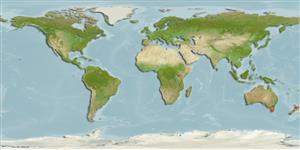Elasmobranchi (squali e razze) (sharks and rays) >
Myliobatiformes (Stingrays) >
Urolophidae (Round rays)
Etymology: Urolophus: Greek, oura = tail + Greek, lophos = crest (Ref. 45335).
More on author: Lacepède.
Environment: milieu / climate zone / depth range / distribution range
Ecologia
marino; salmastro demersale; distribuzione batimetrica ? - 160 m (Ref. 6871). Temperate; 37°S - 44°S
Eastern Indian Ocean: southern Australia.
Length at first maturity / Size / Peso / Age
Maturity: Lm 31.5 range ? - ? cm
Max length : 50.0 cm TL maschio/sesso non determinato; (Ref. 6871)
Inhabits inshore waters, preferably muddy bottoms in the mouths of estuaries and in bays. Also found in rocky reefs (Ref. 12951). Feeds on crustaceans, mollusks, and worms (Ref. 12951). An inactive fish, lying concealed beneath the substrate where it is accidentally disturbed by divers and swimmers.
Life cycle and mating behavior
Maturities | Riproduzione | Spawnings | Egg(s) | Fecundities | Larve
Last, P.R. and J.D. Stevens, 1994. Sharks and rays of Australia. CSIRO, Australia. 513 p. (Ref. 6871)
IUCN Red List Status (Ref. 130435)
Human uses
Strumenti
Special reports
Download XML
Fonti Internet
Estimates based on models
Preferred temperature (Ref.
123201): 13.7 - 16.6, mean 15.1 °C (based on 164 cells).
Phylogenetic diversity index (Ref.
82804): PD
50 = 0.5000 [Uniqueness, from 0.5 = low to 2.0 = high].
Bayesian length-weight: a=0.00813 (0.00366 - 0.01807), b=3.08 (2.88 - 3.28), in cm total length, based on LWR estimates for this (Sub)family-body shape (Ref.
93245).
Trophic level (Ref.
69278): 3.4 ±0.44 se; based on food items.
Generation time: 6.1 ( na - na) years. Estimated as median ln(3)/K based on 2
growth studies.
Resilienza (Ref.
120179): Basso, tempo minimo di raddoppiamento della popolazione 4.5 - 14 anni (Assuming fecundity<100).
Fishing Vulnerability (Ref.
59153): Moderate to high vulnerability (52 of 100).
Nutrients (Ref.
124155): Calcium = 7.56 [1.13, 143.45] mg/100g; Iron = 0.26 [0.03, 3.04] mg/100g; Protein = 20 [15, 25] %; Omega3 = 0.413 [0.119, 1.256] g/100g; Selenium = 9.59 [1.87, 48.21] μg/100g; VitaminA = 8.38 [0.74, 84.96] μg/100g; Zinc = 0.559 [0.045, 5.986] mg/100g (wet weight);
